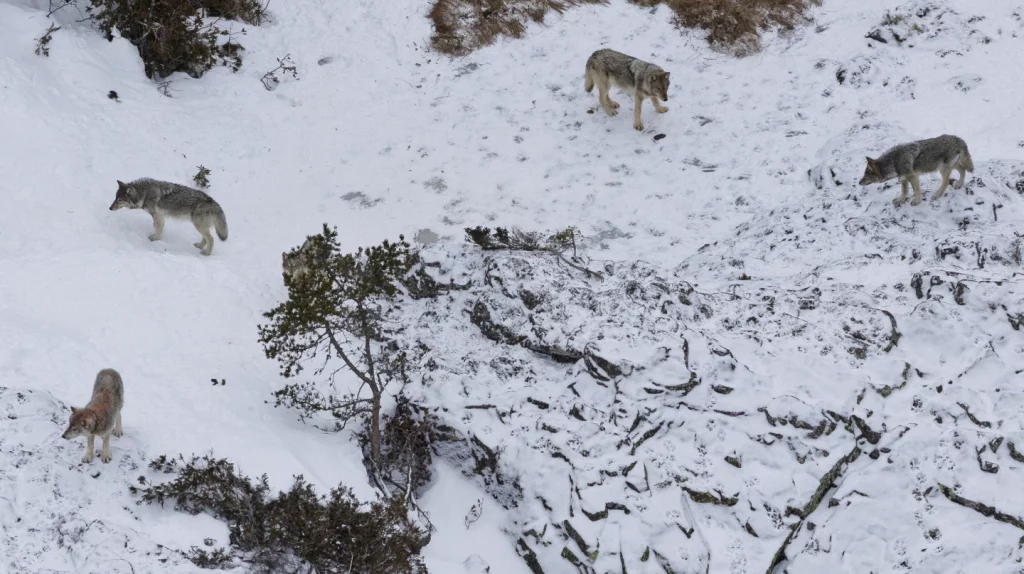
AP had an interesting story about the reintroduction of wolves on Isle Royale, a National Park that is an island. Wolves apparently had only been there since the 1940’s. Even in Wilderness, there are disagreements about when intervention should occur and to what end.
Scientists believe the island’s first moose swam to Isle Royale around the turn of the 20th century. Wolves arrived in the late 1940s, apparently crossing the frozen lake surface from Minnesota or the Canadian province of Ontario. Though technically part of Michigan, that state’s shores are farther away.
Moose provided an ample food supply for the wolves, which in turn helped keep moose numbers in check. Both populations rose and fell over the years, influenced by disease, weather, parasites and other factors. But inbreeding finally took its toll on the wolves, whose numbers plummeted between 2011 and 2018.
*************
The scientists’ annual report, based largely on aerial observations last winter, estimated the rebuilt population at 31 wolves— up from 28 last year. It said the wolves appeared to be forming three packs, with others wandering alone or in smaller groups. The moose total was roughly 967, down from 1,346 last year and 54% decline from about 2,000 in 2019. Ecologists are celebrating what they hope will be a healthier herd.
“It’s been hugely successful,” said study co-leader Sarah Hoy, a research assistant professor and animal ecologist. “That’s what everyone was hoping for.”
But the early results haven’t settled a debate over whether people should rescue struggling species at Isle Royale or other designated wilderness areas, where federal law calls for letting nature take its course.
“We have felt and still believe that the National Park Service should not have intervened and set up this artificial population of wolves,” said Kevin Proescholdt, conservation director for the advocacy group Wilderness Watch.
Some experts said they should be allowed to die out, as have other species that once occupied the island, including Canada lynx and woodland caribou, which had the same predator-prey relationship as today’s wolves and moose.
“Species come and species go,” Proescholdt said, arguing that the federal Wilderness Act “directs us to let nature call the shots and not impose our human desires.”
Park officials and Michigan Tech scientists contend the absence of a top-of-the-food-chain predator of moose and beaver would have been ruinous for the island’s forest. Even now, its balsam firs continue to deteriorate from moose browsing and an attack of tree-killing spruce budworm, the report said.
*********************
The moose population’s 28% drop from 2022 is one of the biggest one-year collapses ever seen at the park, it said. While wolf predation is partly responsible, necropsies indicate the biggest cause was starvation from overpopulation.
Even though relatively few moose calves appear to be surviving to adulthood, there’s no reason to worry about the moose’s immediate future, Michigan Tech biologist Rolf Peterson said. They’ve fallen to 400-500 before and bounced back. But the warming climate, tick infestations and other long-term challenges will remain.
For now, the park’s ecosystem is getting healthier thanks to the wolves’ return, he said, suggesting the decision to intervene was correct.
“The old hands-off approach to managing national parks, figuring everything will turn out OK, is probably not sufficient,” Peterson said. “Our footprint is all over the entire globe.”
If hands-off is not sufficient for National Parks, then, why would we think it is for Forest Service or BLM? Or perhaps it’s not a question of hands-offness so much as who gets to decide when to be hands-on and for what reasons.
Depends on if it’s a species they like or not.
They like wolves so they had to import some. Just wait, eventually there will be hardly any moose, inbreeding to the extent that no pups are born, collapse of wolf population, again, and then the whole thing all over again.
Alternatively they could reintroduce caribou and lynx, decide what numbers to have for all four species, and issue tags to maintain population objectives, like Aldo would do.
“If hands-off is not sufficient for National Parks, then, why would we think it is for Forest Service or BLM? Or perhaps it’s not a question of hands-offness so much as who gets to decide when to be hands-on and for what reasons.”
Sharon: 99% of Isle Royale National Park was designated the Isle Royale Wilderness by Congress in 1976. No matter if it’s the NPS, USFS, BLM, or USFWS….designated Wilderness areas are supposed to be ‘managed’ differently.
I get that.. so what do you think is the right thing to do in Wilderness in this case?
Hi Sharon,
Here are a few links to more information from Wilderness Watch on this specific issue:
https://wildernesswatch.org/we-vote-for-nature-s-way
https://wildernesswatch.org/keeping-wilderness-wild-blog-post/isle-royale-wolves-i-vote-for-nature-s-way
https://wildernesswatch.org/images/wild-issues/2016/10-2015-Camenzind-Isle-Royale-Intervention.pdf
If 200 square miles of island has somewhere over 10,000, even 15,000 visitors a year, in the short time period it is open in the summer, via motorized boats, is it really still ‘wilderness’?
https://www.nps.gov/isro/learn/management/statistics.htm
“the park’s ecosystem is getting healthier”
Based on what criteria? Should they be trying to apply land-based large-landscape concepts to an island with intermittent connections to the mainland? It sounds like the (healthy) NRV there is a series of booms and busts. But I agree that managing Isle Royale as a legal wilderness may not be best use of this island.